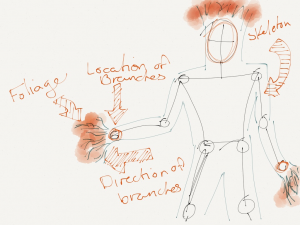Evan Sheehan :: Final Project :: Be A Tree
Be a Tree is an interactive installation wherein the viewer is transformed into, well, a tree. While standing in front of the piece with arms raised, the viewer’s body forms the trunk, and the arms form large boughs, as branches sprout from the viewer and eventually grow blossoms at their tips.
Be A Tree
My final project is an interactive installation wherein the viewer is transformed into a tree while standing in front of the piece with arms raised. The body forms the trunk, and the arms form large boughs, as branches sprout from the viewer and eventually grow blossoms at their tips. Built using openFrameworks, the piece uses OpenNI to detect the viewer’s pose and place branches along the torso and arms.
The source is available on github.
How It Works
The tree branches are simply stored in a binary tree (see what I did there?) structure; each node contains a length and angle. Drawing the branches is then simply a matter of traversing the binary tree in a depth-first manner and, at each node, applying a translation and rotation to the canvas before drawing. I used ofxOpenNI to set up the kinect and detect the user’s skeleton. I attached branches to various limbs on the skeleton such as the shoulder, humerus, and head. The entire branch structure is generated when the user is detected by OpenNI, and growth is simulated by progressively drawing deeper in the tree structure. Once a limb has reached its terminus, blossoms are added progressively to the end of the limb.
The silhouettes were drawn simply use the user masks provided by ofxOpenNI. Initially (as seen above), the silhouettes were drawn using vertices added to an openFrameworks shape. But this approach resulted in jagged, noisy silhouettes. To smooth out the noise in the silhouettes, I ended up using ofPaths instead.
Inspiration
I don’t really recall from whence this project idea came. I set out to continue my previous project by creating beings that constructed dwellings that were destroyed by viewers of the piece. At some point it changed in my imagination to a piece where the viewers were trees providing the habitat for forest creatures to appear. Eventually I dropped the creatures entirely, and here we are.
Preliminary Tests
Below you can see some of my preliminary tests where I had abandoned the human silhouette entirely. It was through conversations with the Professor’s 5-year-old son that I realized it was important that the people remain identifiable in the piece.


